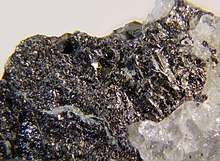Ferroselite
Orthorhombic ferroselite and its isometric polymorph dzharkenite are iron selenides of general formula FeSe2 precipitated under reducing conditions in anoxic environments. They are a source of selenium in the Rocky Mountains where selenium occurrence is associated with Upper Cretaceous shale deposits.
| Ferroselite/ Dzharkenite | |
|---|---|
 Ferroselite found in Argentina | |
| General | |
| Category | Selenide mineral |
| Formula (repeating unit) | FeSe2 |
| Strunz classification | 2.EB.10a |
| Crystal system | Orthorhombic/ Cubic |
| Identification | |
| Color | Steel-gray to tin-white with a rose tint, brass yellow |
| Crystal habit | Acicular prismatic |
| Twinning | Stellate and cruciform twins common |
| Mohs scale hardness | 6 - 6.5 |
| Luster | Metallic |
| Streak | Black |
| Specific gravity | 7.20 |
| Refractive index | Opaque |
| Pleochroism | Distinct |
| Solubility | insoluble in water |
| References | [1][2][3] |
In the frame of safety assessment calculations made for deep disposal of high-level radioactive waste, ferroselite and dzharkenite are also considered in geochemical calculations as one of the mineral phases limiting the solubility of Selenium-79.[4]
Names
Dzharkenite's type locale is in the Suluchekinskoye Se-U deposit in the Dzharkenskaya Depression of the Middle Ili River, Almaty Province, in southeastern Kazakhstan. It was discovered in 1995 and named after the depression.
Ferroselite was first reported in 1955 for an occurrence in the Ust’-Uyuk uranium deposit in Tuva, Siberia.[1] Its name comes from the Latin ferro (iron) and "sel" for selenium.
See also
- Coccolithophorid, a group of marine planktonic unicellular algae fixing selenium in Upper Cretaceous chalk and shale formations
- Emiliania huxleyi, a major species of coccolithophorid active in selenium bioconcentration
External links
- Dzharkenite (FeSe2) on mindat.org
- Dzharkenite (FeSe2) on webmineral.com
References
- Ferroselite (FeSe2) on mindat.org
- Ferroselite (FeSe2) on webmineral.com
- Ferroselite (FeSe2) in Handbook of Mineralogy (rruff.geo.arizona.edu)
- "Marivoet et al. (2001) Safir 2 report. Ondraf/Niras" (PDF). Archived from the original (PDF) on 2011-04-30. Retrieved 2010-01-06.